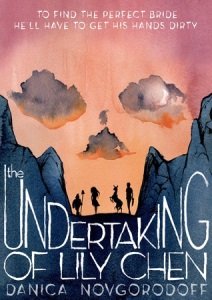2018 School Spending Survey Report

Find more great Horn Book content at these links:
Recommended books: reviews and themed booklists
App and e-book reviews
Movie reviews
Event news and recaps
Events calendar
'Til death do we part? The Undertaking of Lily Chen
The Undertaking of Lily Chen (First Second, March 2014), Danica Novgorodoff’s latest graphic novel, begins with an excerpt from an article published by The Economist in 2007:
Parts of rural China are seeing a burgeoning market for female corpses, the result of the reappearance of a strange custom called “ghost marriages.
Parts of rural China are seeing a burgeoning market for female corpses, the result of the reappearance of a strange custom called “ghost marriages.” Chinese tradition demands that husbands and wives always share a grave. Sometimes, when a man died unmarried, his parents would procure the body of a woman, hold a “wedding,” and bury the couple together… A black market has sprung up to supply corpse brides[…] At the bottom of the supply chain come hospital mortuaries, funeral parlors, body snatchers — and now murderers.
 The epigraph — taken from an article published within the last decade about a real phenomenon — sets a grisly tone for this noteworthy paperback from First Second.
The epigraph — taken from an article published within the last decade about a real phenomenon — sets a grisly tone for this noteworthy paperback from First Second.After Deshi accidentally kills his unmarried older brother during an altercation on a military base, he is tasked (by his grieving parents) with acquiring a corpse bride to accompany his brother to the afterlife. With a large sum of money, Deshi hires an unscrupulous “marriage broker” to help him find a fresh body, but they get interrupted and separated before they can finish the job.
As Deshi tracks down his lost pack mule, he happens upon Lily Chen, a modern girl living in old fashioned township who wishes to escape her rural surroundings, her overbearing father, and a potential arranged marriage. Free-spirit Lily forces charms her way into running away with Deshi, believing they’re heading toward Beijing, while Deshi, desperate to fulfill his obligation to his parents (who always favored their eldest son), contemplates murdering Lily as a last resort. Complications arise as he ends up falling in love with her.
Aspects of modern-day China collide with ancient Chinese traditions in both content and artistic style. Deshi and Lily struggle to reconcile their own personal aspirations with their responsibilities to family traditions. Novgorodoff underscores this struggle in her art. She uses soft watercolor brushwork for rolling landscapes and strong black ink outlines for mountain-scapes effectively calling to mind classical Chinese painting techniques, while the presence of modern technology, contemporary clothing, and typical comic book onomatopoeia contrast with that aesthetic.
The grim subject matter is skillfully balanced with keen humor, genuine sentiment, and humanizing struggle.
RELATED
RECOMMENDED
ALREADY A SUBSCRIBER? LOG IN
We are currently offering this content for free. Sign up now to activate your personal profile, where you can save articles for future viewing.






Add Comment :-
Be the first reader to comment.
Comment Policy:
Comment should not be empty !!!